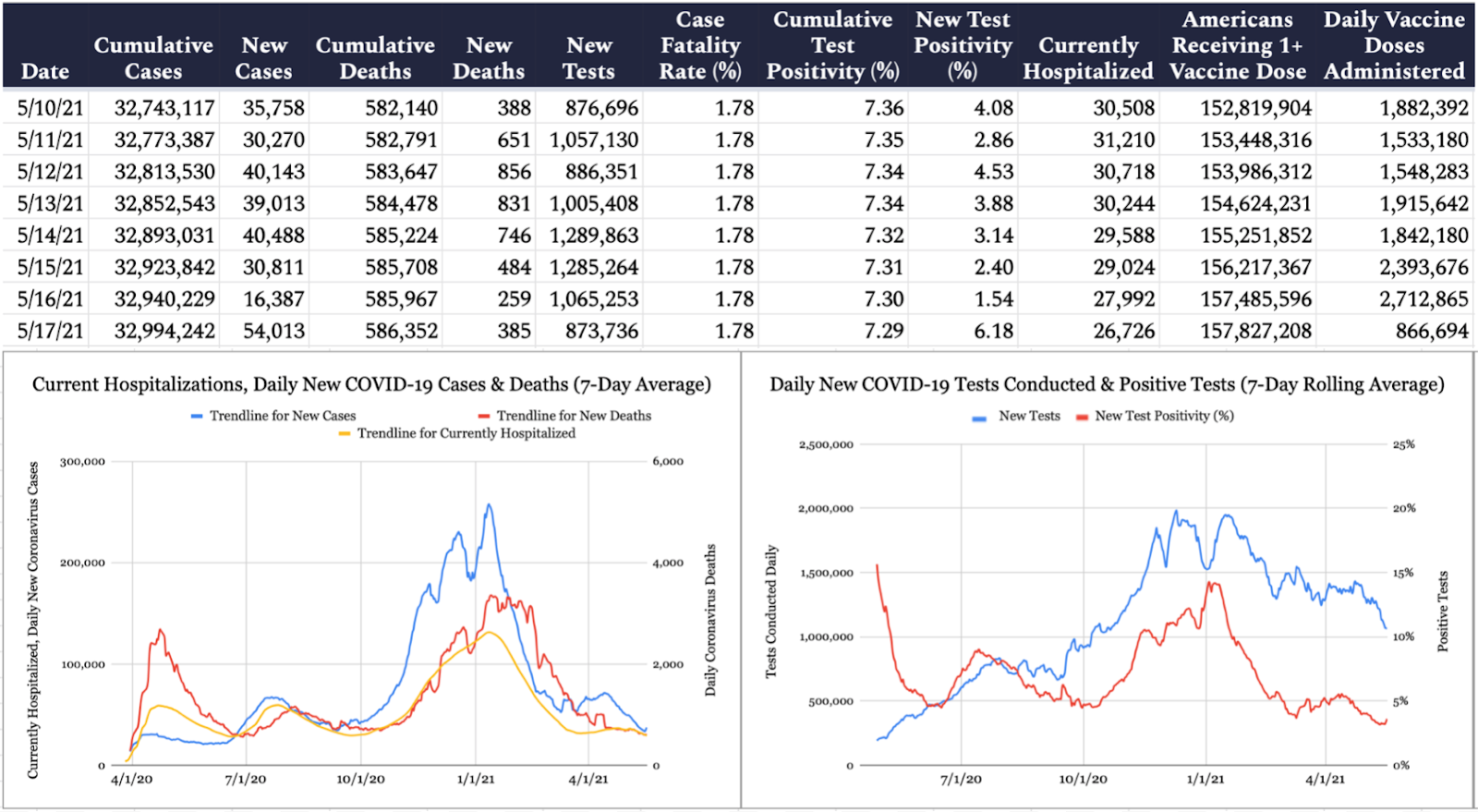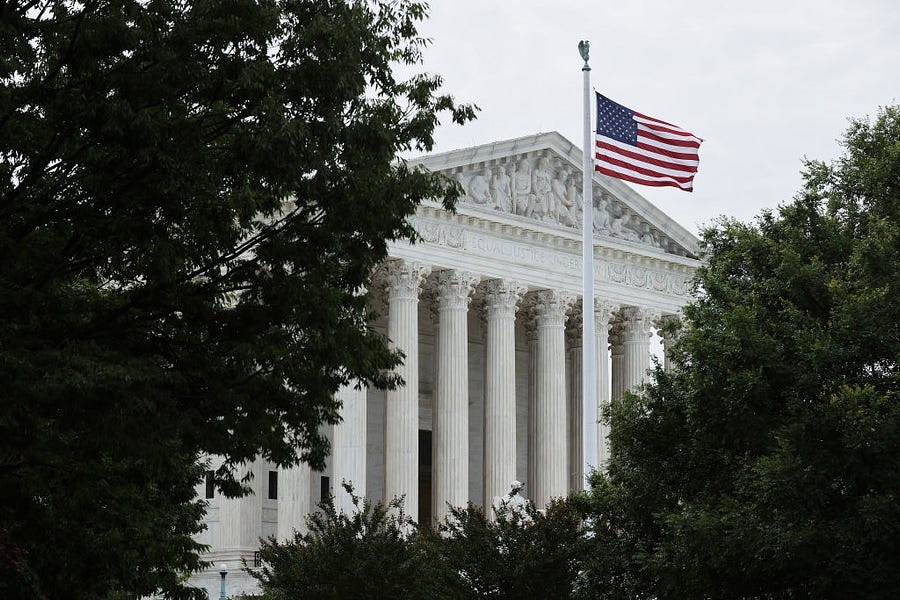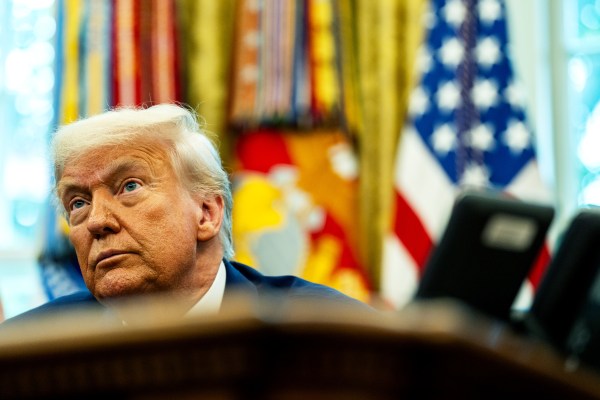Happy Tuesday! It’s possible we spoke too soon yesterday about the cicadas.
Quick Hits: Today’s Top Stories
-
The Supreme Court on Monday agreed to hear a case concerning a Mississippi law banning abortions after 15 weeks, the most direct challenge to Roe v. Wade the conservative-majority court has tackled yet.
-
In a Monday call with Israeli Prime Minister Benjamin Netanyahu, President Joe Biden “expressed his support for a ceasefire” but “reiterated his firm support for Israel’s right to defend itself against indiscriminate rocket attacks,” according to a White House readout.
-
Top Republicans on the Maricopa County Board of Supervisors blasted fellow Republicans pushing additional audits of the 2020 election results as conspiracy theorists and grifters. “We ran a bipartisan, fair election. That’s every piece of evidence that I’ve ever seen put in front of us,” said Clint Hickman, a Republican supervisor. “We are operating on facts and evidence presented to this board.” The county’s top election official, Stephen Richer, also a Republican, called new claims of irregularities from former President Donald Trump “unhinged.”
-
The Biden administration announced Monday the U.S. would send an additional 20 million doses of the Moderna, Pfizer, and Johnson & Johnson coronavirus vaccines to countries struggling to meet demand next month. The new doses will be on top of the 60 million doses of AstraZeneca vaccine that are set to be released pending FDA approval.
-
The Treasury Department said that the child allowance payments passed in Democrats’ March stimulus package—up to $300 per child per month for a single year—will be distributed starting July 15.
-
Joel Greenberg, a former county tax collector with strong ties to Florida congressman Matt Gaetz, pleaded guilty Monday to federal crimes including sex trafficking a minor. The New York Times reported last month that Gaetz himself is under federal investigation for possible sex trafficking crimes.
-
The United States confirmed 54,013 new cases of COVID-19 yesterday per the Johns Hopkins University COVID-19 Dashboard, with 6.2 percent of the 873,736 tests reported coming back positive. An additional 385 deaths were attributed to the virus on Monday, bringing the pandemic’s American death toll to 586,352. According to the Centers for Disease Control, 26,726 Americans are currently hospitalized with COVID-19. Meanwhile, 866,694 COVID-19 vaccine doses were administered yesterday, with 157,827,208 Americans having now received at least one dose.

Supreme Court to Hear Major Abortion Case
The Supreme Court on Monday agreed to hear oral arguments for Dobbs v. Jackson Women’s Health Organization, a case that challenges the constitutionality of a Mississippi state law that permits abortions after 15 weeks of gestational age only in cases of medical emergency or instances of severe fetal abnormality. In a one-line order issued on Monday, the Supreme Court said it will rule next term on the long-standing question of whether all pre-viability bans on elective abortions are unconstitutional.
Legal experts and abortion activists say this case presents an opportunity for the Supreme Court’s 6-to-3 Republican-appointed majority to modify or even overturn Roe v. Wade and Planned Parenthood v. Casey, two cases that have governed abortion law for decades.
“Anti-abortion politicians have exploited their power for this exact moment: the opportunity for the newly comprised Supreme Court to take away our right to abortion,” Planned Parenthood Action Fund President Alexis McGill said Monday. “By taking this case, the court will be reviewing nearly 50 years of precedent guaranteeing our right to abortion. In a country where your ability to access abortion already depends on your income and ZIP code, the court’s decision could even further decimate access.”
Abortion case law’s thorny history dates back to 1973, when the Supreme Court constitutionalized a woman’s right to an abortion in Roe v. Wade. The landmark ruling created an absolute right to an abortion in the first trimester of pregnancy, but held that states could regulate the practice in the second trimester pursuant to the compelling interest of protecting maternal life. Roe also held that states had a compelling interest in protecting fetal life at the start of the third trimester, when the fetus is considered viable and can survive outside the womb.
Roe’s trimester framework was later thrown out in Planned Parenthood v. Casey, a 1992 case which held that states could impose legislative restrictions on abortion so long as those restrictions did not impose an “undue burden” on a woman’s right to seek an abortion. A regulation imposes an “undue burden” on the right to an abortion if its “purpose or effect is to place a substantial obstacle in the path of a woman seeking an abortion before the fetus attains viability.” (Emphasis in original.)
For now, Casey’s permission structure for legislative restrictions on abortion at any point in the pregnancy still does not permit outright prohibitions on pre-viability elective abortions. The 5th U.S. Circuit Court of Appeals said as much when it struck down Mississippi’s Gestational Age Act in 2019 on the grounds that viability is still the “governing constitutional standard.”
Legal experts were surprised that the Supreme Court decided to grant certiorari—or order the case for review from the lower court—for a number of reasons. First, the 5th Circuit’s decision to agree with the district court means there is no circuit split. The overwhelming majority of cert grants are given to cases where there is a circuit split. Second, even though only four justices are required to grant cert, five votes are needed to actually decide a case. The fact that the judges agreed to grant cert in this case means that at least four justices are now likely confident they can find a fifth (or sixth) vote for their preferred position.
“There is now presumed to be a 6-3 majority of pro-life justices to varying degrees,” our own David French said on Monday’s episode of Advisory Opinions. (Listen here for an in-depth discussion of the case.) “The only person that we know really where they truly stand on these underlying abortion rights questions is Justice [Clarence] Thomas, who has written clearly that he thinks Roe and Casey are bad law. We also know that the three justices who are Democratic nominees are strongly supportive of Roe or Casey.”
But the court’s other five justices, including Chief Justice John Roberts, are harder to pin down. In a 2020 case called June Medical Services LLC v. Russo, Roberts surprised many abortion activists when he sided with the four liberal justices in striking down a Louisiana law that required doctors who perform abortions to have admitting privileges at a nearby hospital.
Now that Trump-appointed Justice Amy Coney Barrett has succeeded the late Justice Ruth Bader Ginsberg on the bench, legal experts say that Dobbs offers the court’s conservative majority an ideal opportunity to overturn or at least amend existing abortion case law even without the support of Chief Justice Roberts. The court is expected to issue its opinion in the spring or summer of 2022.
CDC and The Holdouts
As we wrote yesterday, the CDC’s updated COVID guidance concerning masks has lit a fire under states, local governments, and national businesses like Target and Starbucks to move away from policies requiring masking among the vaccinated. Just yesterday, California and New York announced they would move toward lifting their mask mandates, albeit on two very different timetables—New York effective tomorrow, California not until June 15 with the caveat that this date could be pushed back.
“New Yorkers have worked hard over the last year to prevent the spread of COVID and keep each other safe,” Gov. Andrew Cuomo said in a press release. “That work has paid off and we are ecstatic to take this next step in the reopening of our beautiful state.”
A few stragglers, however, have continued to forge ahead with broad mandates and no plans as yet to lift them. New Jersey Gov. Phil Murphy said Monday he is keeping his state’s indoor mask mandate intact, although he is ditching the outdoor mandate for fully vaccinated New Jerseyans.
“As far as we can tell and as much as we want to get there—and we will get there, as it relates to indoor masking, it’s only a matter of time—if you’re in a business and a public setting, we’re not there yet. We’re frankly not there yet,” Murphy said at a vaccination event with actress and comedian Whoopi Goldberg.
On Twitter, the governor pointed to a post from Dr. Ashish Jha of the Brown University School of Public Health arguing that businesses and states “should wait a bit” given that many U.S. adults didn’t become eligible for vaccination until late April. This means even some of those who got in line right away won’t be fully vaccinated until mid-June.
Dr. Howard Forman, a health policy professor at the Yale University School of Medicine, told The Dispatch that this slapdash rollout of new policies, with wildly diverging strategies even among states that are largely ideologically simpatico, has a lot to do with the abruptness of the CDC announcement: “Some of the states are just taking their time to come up with what their policy is because they didn’t expect this to occur as fast as it did.”
Some think the CDC also did states and cities no favors by declining to weigh in on many of the logistical factors surrounding mask policy. “In an ideal world, we would have some sort of metrics provided to mayors and governors to help figure out when is the right time to lift a mandate,” Dr. Megan Ranney, an emergency physician and professor at Brown University, told The Dispatch. “It would have been lovely to have that accompanying this announcement to help clarify—because, you know, mayors are not public health professionals; that’s not their job.”
At the same time, while these sorts of government decisions drive the public conversation surrounding the pandemic, their power to actually determine pandemic outcomes—or even influence public behavior—can be overstated.
The first state to fully reopen, long before the CDC announced its new mask guidelines, was Texas: Gov. Greg Abbott issued an executive order on March 2 that lifted all mask mandates in the state and all capacity limits on businesses. The move was met with criticism from media and state Democrats, who warned that Abbott was playing with fire given the still-high case numbers in the state. “Gov. Abbott needs to quit obeying his political impulses and listen to the health experts, who are warning that it is too soon to let our guard down without risking potentially disastrous consequences,” said the president of the Texas State Teacher Association at the time.
Two and a half months on, no disastrous new wave has materialized in Texas—but interestingly, the reopening has been muted in the weeks since, too. A recent study by the National Bureau of Economic Research looked at daily coronavirus data, economic data, and cell phone data meant to track “foot traffic,” to see if Texas residents were in fact going out more since the removal of restrictions. The results showed that basically nothing changed. “Together, our null findings underscore the limits of late-pandemic era COVID-19 reopening policies to alter private behavior,” the paper said.
In other words, at this point in the pandemic most people have already settled on what they see as the appropriate level of viral risk—and they aren’t waiting around for their state to tell them how many precautions they ought to be taking.
Worth Your Time
-
It’s tempting to believe that conspiratorial, tin-hat thinking is something only other people are susceptible to—especially people less educated and more credulous than we imagine ourselves to be. Which is why this piece from the New York Times’s Ben Smith is so fascinating in its depiction of a moral panic that descended on a small online community of former winners of the quiz show Jeopardy! after a contestant who had just won his third game held up three fingers on his right hand—a gesture which, the contestants quickly decided, was likely some sort of white power symbol. “The element of this story that interests me most is how the beating heart of nerdy, liberal fact-mastery can pump blood into wild social media conspiracy, and send all these smart people down the sort of rabbit hole that leads other groups of Americans to believe that children are being transported inside refrigerators,” Smith wrote. “It reflects a depth of alienation among Americans, in which our warring tribes squint through the fog at one another for mysterious and abstruse signs of malice.”
-
The Endless Frontier Act, which was introduced in the Senate by Sen. Chuck Schumer and has the support of several Republicans, aims to put the United States in a better position to compete with China by investing in technological innovation, including in artificial intelligence and high-powered computing. The bill means well but does not go far enough to eclipse China’s effort in the same industries, Stuart Anderson of the National Foundation for American Policy argues in an article for Reason. Anderson also contends that the bill should do more to encourage Chinese people to immigrate to America and stay here by reforming existing visa policies.
Presented Without Comment
Toeing the Company Line
-
On Monday’s Advisory Opinions, David and Sarah tackle the huge news about the Supreme Court’s abortion case, walking through possible outcomes and how it fits in with the court’s previous jurisprudence on abortion questions. They also discuss Caniglia v. Strom, a unanimous Supreme Court ruling this week concerning warrantless police searches of homes.
Let Us Know
Where is your state on mask mandates? Are you listening to state and federal guidance to determine your approach to masking and returning to normal or are you making your own decisions?
Reporting by Declan Garvey (@declanpgarvey), Andrew Egger (@EggerDC), Haley Byrd Wilt (@byrdinator), Audrey Fahlberg (@FahlOutBerg), Charlotte Lawson (@charlotteUVA), Ryan Brown (@RyanP_Brown), and Steve Hayes (@stephenfhayes).
Correction, May 18, 2021: An earlier version of this newsletter mistakenly said that Delaware has not changed its masking restrictions in light of new CDC guidelines. In fact, Delaware’s indoor mask mandate will expire this Friday.







Please note that we at The Dispatch hold ourselves, our work, and our commenters to a higher standard than other places on the internet. We welcome comments that foster genuine debate or discussion—including comments critical of us or our work—but responses that include ad hominem attacks on fellow Dispatch members or are intended to stoke fear and anger may be moderated.
With your membership, you only have the ability to comment on The Morning Dispatch articles. Consider upgrading to join the conversation everywhere.